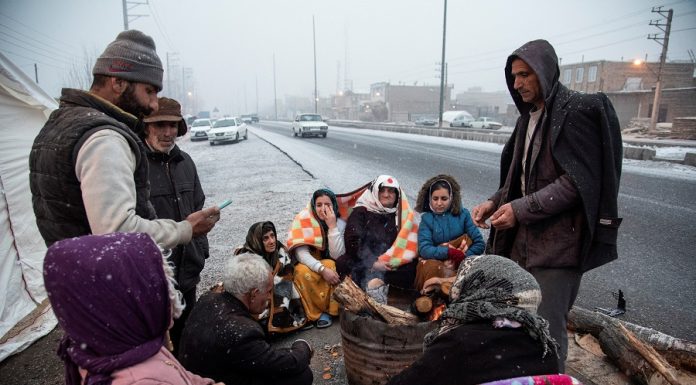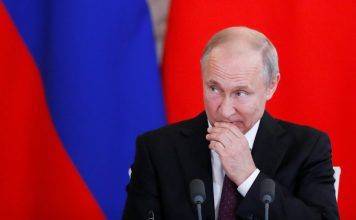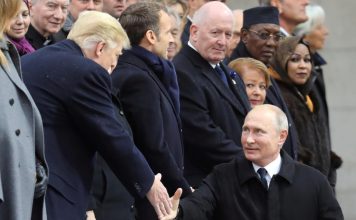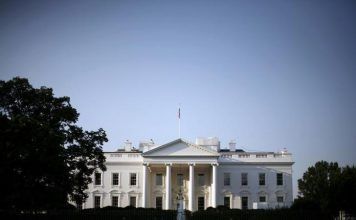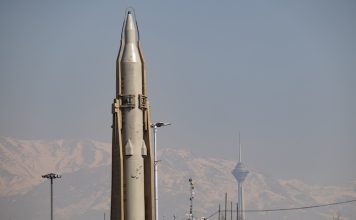By Kayhan Life Staff
Failure to provide emergency aid to the victims of a 5.9-magnitude earthquake that struck Khoi and surrounding villages, in the northwestern province of West Azerbaijan, on Jan. 28 has again exposed the Islamic Republic’s inadequate crisis management program.
[aesop_image img=”https://kayhanlife.com/wp-content/uploads/2023/02/2023-01-29T083447Z_771745395_RC220Z9DN92Z_RTRMADP_3_IRAN-QUAKE.jpg” panorama=”off” credit=”People gather near a fire after an earthquake in Khoy county, West Azerbaijan, Iran, January 29, 2023. REUTERS./” align=”center” lightbox=”off” captionsrc=”custom” captionposition=”left” revealfx=”off” overlay_revealfx=”off”]
The victims of the recent earthquake in Khoi have been living outdoors in dangerously cold temperatures with no food, clean water, heating, or temporary shelters.
While the emergency services have failed to provide much-needed assistance to the people of Khoi and surrounding villages, Iran has offered to help the victims of the 7.8-magnitude earthquake that struck southern Turkey and northern Syria on Feb. 6, killing some 5000 people so far.
One reason for the lack of a robust crisis management program in Iran is that, as in previous years, the largest part of the government’s 2023-24 budget bill is earmarked for the military, religious and ideological, and Islamic propaganda institutions — instead of being invested in boosting the capabilities of emergency services and aid organizations such as the Iranian Red Crescent Society, which could help victims of natural disasters.
Many people in Khoi and surrounding villages have been awaiting medical help, food, clean drinking water, heaters, and temporary shelter since their houses were destroyed in the earthquake more than a week ago.
An article headlined “Hear Our Cries from the Heavy Heart of a City Hit by an Earthquake,” published by the Tehran-based Etemad newspaper on Feb. 5, highlighted the plight of the victims of the Khoi earthquake.
“Here is Khoi; people walk with fear, knowing that death can come with an aftershock,” the paper said. “Rumors are circulating in the city. However, nothing can shut people up, not even armed antiriot forces who stand guard at the weather center, with their faces covered.”
“There are no officials here,” the paper noted, quoting some residents. “They visited briefly and left quickly. They made some promises and then disappeared.”
“The earthquake has destroyed many parts of the city,” the paper explained. “People are frightened, waiting for something, but do not know what. They walk through ruins that were their homes until two weeks ago. The city still experiences tremors and aftershocks. Some men cry in despair, and many women, with their chador [full-body veil] tied around their waists, rummage through the collapsed buildings, unearthing furniture and other belongings.”
People of Khoi may find it puzzling and even painful that the Iranian government is ready to help the victims of the recent devastating earthquake in Turkey and Syria but cannot provide emergency aid to its citizens.
That does not come as a massive surprise, given the repeated failure of the Islamic Republic’s crisis management program, including its handling of the aftermath of natural disasters or those caused by human error, the most notable example of which was the collapse of Plasco Building, a 20-story high-rise landmark in Tehran, destroyed by a fire on Jan. 19, 2017.
Mismanagement and incompetence are endemic in the Islamic Republic. Lack of adequate funding is one of the principal reasons for the country’s ineffective crisis management program. Failure to help tens of thousands of people in Khoi and surrounding villages who lost their homes in the earthquake and desperately need food, water, medicine, and shelter has exposed the lack of funding for emergency services and aid organizations like the Red Crescent Society.
The Red Crescent Society received $87.7 million (based on the current rate of 42,200 tomans to a U.S. dollar) in 2021-22 and $144.6 million in 2022-23. It will receive $189.6 million in 2023-24, which is about $2 per person for the country’s entire population.
In comments reported by the Iranian Students News Agency (ISNA) on Nov. 3, Namdar Abdollahian, the Red Crescent Society’s deputy for planning and parliamentary affairs, said that the “organization’s budget should be increased from the current $144.6 million to $2.3 billion”.
A month earlier, Mohsen Zanganeh, a member of the Majlis’ Program, Budget, and Accounting Commission, told the Islamic Republic News Agency (IRNA) that the Red Crescent Society’s budget did not match the organization’s massive operation.
“Low salaries and wages of people working for the Red Crescent Society is the main issue,” Mr. Zanganeh said. “The organization’s workforce conducts vast operations which are covered by the salaries and wages under the law. The other problem is inadequate and outdated equipment which should be upgraded but is not.”
The president of the Red Crescent Society, Pir Hossein Kolivand, has also highlighted the problem with low salaries and dilapidated equipment.
In comments reported by the Tehran-based Tasnim news agency on Dec. 31, Mr. Kolivand warned about the “exhausted” workforce, the need to boost the “operational capacity” of the organization, and the “lack of sufficient funding to improve the response time of the teams to the environmental crisis.”
Iran’s Poor Water Management Chief Cause of Flash Floods, Expert Says
The head of the Red Crescent Society’s Emergency Relief and Rescue Operations, Mahdi Valipour, recently said the organization needed 54 helicopters, but it had only 24, of which 19 needed a complete overhaul; otherwise, they would be out of commission soon.
“The Red Crescent Society needs 11,000 emergency vehicles but has only 5,000, one-third of which are old,” Mr. Valipour explained. “We have 600 emergency search and rescue stations but need at least 3,000.”
Meanwhile, President Ebrahim Raisi’s 2023-24 Budget Bill, submitted to the Majlis (Iranian Parliament) in mid-January, calls for increasing funds allocated to religious and ideological institutions.
One of the significant features of the 2023-24 budget bill is its increased funding for security forces which have played a crucial role in cracking down on the ongoing nationwide protests sparked by the death of Mahsa (Zhina) Amini, a 22-year-old woman who died while in the custody of the morality police on Sept. 16, in Tehran.
The significant increase in the funds earmarked in next year’s budget for Islamic propaganda, ideological centers, and religious institutions could stem from Iran’s Supreme Leader Ayatollah Ali Khamenei’s “explanation jihad,” which he believes would safeguard the Islamic Republic regime from collapse.
The Armed Forces Social Security Organization will receive $2.7 billion, comprising 74 percent of the funds earmarked for the Ministry of Defense and Armed Forces Logistics. The joint command of the Islamic Revolutionary Guards Corps (IRGC) is to receive nearly $3 billion.
The Law Enforcement Command of The Islamic Republic of Iran (FARAJA) will receive $1.5 billion. Nearly 7 percent of the funds allocated to the force will strengthen its military structure, border security, and ideological and political institutions.
The Foundation of Martyrs and Veterans Affairs will receive $1.76 billion, the second-highest amount after the IRGC. However, the organization needs to clarify how it plans to spend the money.
The Seminaries Service Center (which supports seminary students and pays for their tuition) will receive $146.2 million. The Supreme Council of Qom Seminaries is to receive $73.1 million, a 60 percent increase from the current budget.
The Ministry of Culture and Islamic Guidance will receive $131.7 million. The Headquarters for the Promotion of Virtue and Prevention of Vice is to receive $1.8 million, a 33 percent increase from the current budget.
The Institution for Safeguarding the Sacred War Archives (the Iran-Iraq War between 1980 and 1988) is to receive $10.5 million, a 159 percent increase from the current budget.
The Institute for the Publication of Imam Khomeini’s Works to receive $2.4 million.
The project to maintain Imam Khomeini’s Mausoleum will receive $878,000, a 71 percent increase from the current budget. The Khomeini Family oversees the funds allocated to the Institute for the Publication of Imam Khomeini’s Works and the project to maintain Imam Khomeini’s Mausoleum.
The Computer Research Center for Islamic Sciences (Noor) funding will rise from $930,000 to $1.4 million. The institution oversees the operations of “The Hawzah news website,” “Noor Specialized Journal Website,” and “Noor Digital Library.”
The Center for the Islamic-Iranian Model of Progress will receive $586,000, a 170 percent increase from the current budget.
Iran’s 2023-24 Budget Earmarks Massive Funds for Religious Institutions
OPINION: The Solution to the ‘Iran Problem’ is Regime Change

